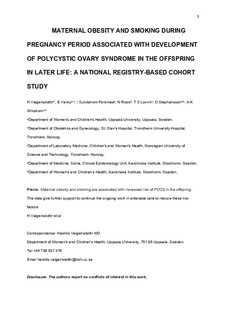Prenatal exposures and birth indices, and subsequent risk of polycystic ovary syndrome: a national registry-based cohort study
Valgeirsdottir, Heiddis; Vanky, Eszter; Sunström-Poromaa, Inger; Roos, Nathalie; Løvvik, Tone Shetelig; Stephansson, Olof; Wickström, Anna-Karin
Journal article, Peer reviewed
Accepted version
Permanent lenke
http://hdl.handle.net/11250/2600969Utgivelsesdato
2018Metadata
Vis full innførselSamlinger
- Institutt for klinisk og molekylær medisin [3426]
- Publikasjoner fra CRIStin - NTNU [37220]
- St. Olavs hospital [2441]
Originalversjon
BJOG: an International Journal of Obstetrics and Gynaecology. 2018, 126 (2), 244-251. 10.1111/1471-0528.15236Sammendrag
Objective
To study the associations between prenatal exposures and risk of developing polycystic ovary syndrome (PCOS).
Design
National registry‐based cohort study.
Setting
Sweden.
Population
Girls born in Sweden during the years 1982–1995 (n = 681 123).
Methods
The girls were followed until the year 2010 for a diagnosis of PCOS. We estimated the associations between maternal body mass index (BMI), smoking, and size at birth with the risk of developing a PCOS diagnosis. Risks were calculated by adjusted hazard ratio (aHR) and 95% confidence intervals (95% CIs).
Main outcome measures
A diagnosis of PCOS at 15 years of age or later.
Results
During the follow‐up period 3738 girls were diagnosed with PCOS (0.54%). Girls with mothers who were overweight or obese had 1.5–2.0 times higher risk of PCOS (aHR 1.52, 95% CI 1.36–1.70; aHR 1.97, 95% CI 1.61–2.41, respectively), compared with girls born to mothers of normal weight. The risk of PCOS was increased if the mother smoked during pregnancy (1–9 cigarettes/day, aHR 1.31, 95% CI 1.18–1.47; ≥10 cigarettes/day, aHR 1.44, 95% CI 1.27–1.64). Being born small for gestational age (SGA) was associated with a later diagnosis of PCOS in crude estimates, but the association was not significant after adjusting for maternal factors.
Conclusions
Maternal smoking and increased BMI appear to increase the risk of PCOS in offspring. The association between SGA and the development of PCOS appears to be mediated by maternal factors.
Tweetable abstract
Smoking during pregnancy and high maternal BMI are associated with PCOS diagnosis in the offspring.
